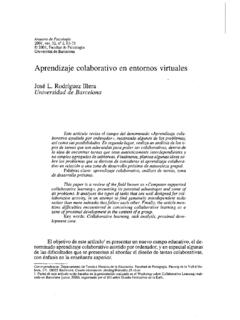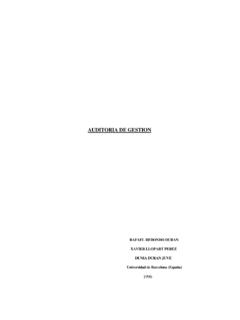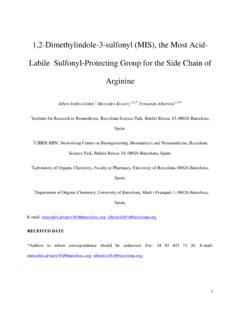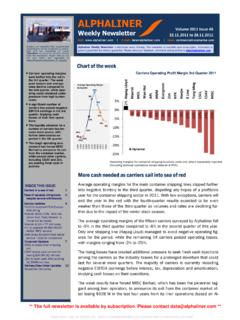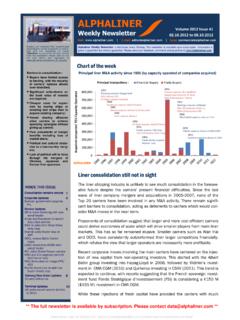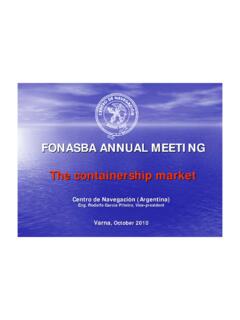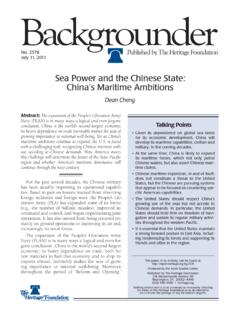Transcription of STRATEGIC ALLIANCES IN LINER SHIPPING - …
1 FACULTAT D ECONOMIA I EMPRESA, UNIVERSITAT DE BARCELONA STRATEGIC ALLIANCES IN LINER SHIPPING CONCENTRATION AND ECONOMIES OF SCALE Student: Andreu Reixach i Sala Advisor: Esteve Sanrom EUS Group, Bachelor s Degree in Economics Faculty of Economics and Business Abstract: The aim of this investigation is to examine the phenomena of STRATEGIC ALLIANCES among maritime carriers. During the last decade this process has accelerated, jointly with the introduction of megaships in the industry.
2 This has caused the number of operators in the market to fall to only four big ALLIANCES controlling the 99% of the market share. The main argument provided by companies is that this process is done to gain economies of scale and operational synergies. In order to test this argument an average cost function that depends on the number of operators in the industry, thus if there are STRATEGIC agreements or not among carriers, has been estimated and it has been found to decrease when STRATEGIC ALLIANCES are established. This means a better situation in terms of efficiency due to the concentration of the sector but it does not mean lower prices or an increase in the general level of welfare.
3 Testing this goes far from the scope of this research but it could be interesting to pursue the investigation in the future. Resum: L objectiu d aquest treball de fi de grau s investigar el fenomen de les aliances estrat giques entre les empreses navilieres que operen en el sector del transport mar tim. Durant la darrera d cada aquest proc s s ha vist accelerat i ha anat de la m de la creaci i posta en operaci de portacontenidors cada cop m s grans fins al punt d arribar-se a encarregar vaixells de fins a TEUs, la unitat est ndard de mesura en el sector de la log stica mar tima. El proc s de formaci d aliances ha estat justificat argumentat que aquestes suposen guanys a nivell d efici ncia, sin rgies operacionals i economies d escala, a m s del fet de permetre posar en operativa vaixells m s grans amb la reducci en el cost total mig Carrier LINER SHIPPING Vessel Economies of scale Concentration STRATEGIC alliance Operational synergies Cost function TEU Utilization per TEU que aix suposa.
4 Que existeixen economies d escala a nivell de vaixell, s a dir que el cost per TEU si s utilitza un vaixell m s gran s menor que en el cas de utilitzar-ne un de petit, s quelcom generalment acceptat en la literatura i en el sector, el que no est acceptat s que el mateix passi en el cas de les navilieres, que si en comptes de dues empreses operant de forma separada nom s ni ha una, s a dir que la mida mitjana de l operador incrementi, el cost per TEU decreixi. Aquest treball t l objectiu de testar aquest argument, de provar si existeixen o no economies d escala a nivell de naviliera i si una alian a estrat gica significa una reducci de costos o no.
5 Per fer-ho s ha estimat una funci de cost total mig, cost per TEU, a nivell de vaixell. Per establir la relaci entre el vaixells i les navilieres o aliances que els operen s ha introdu t en aquesta funci una variable que representa la utilitzaci dels vaixells i s ha estimat un model econom tric per esbrinar si aquesta variable varia al formar-se aliances o no. S ha trobat que la concentraci en la ind stria i la formaci d aliances afecta positivament el grau d utilitzaci mig dels portacontenidors i que la funci de costos depenent del nombre d operadors en la ind stria t pendent negativa, per tant que es formessin aliances estrat giques entre les diferents navilieres suposaria increments en el nivell d efici ncia de la ind stria i reduccions de costos.
6 Aix no vol dir que hi hagin millores a nivell d excedent del consumidor, que el benestar total incrementi o que els preus del noli baixin, tot aix est lluny del que avarca aquest treball per degut a la import ncia que t el transport mar tim per a la bona salut d una economia global seria interessant continuar la investigaci en el Introduction: .. 1 Objectives:.. 4 An overview on previous literature .. 5 Methodology .. 8 Results: .. 14 Conclusions .. 28 Bibliography .. 321 Introduction: Recent years, especially after the global crisis that hit the world and had tremendous effects on global maritime transport, have been truly interesting for agents implicated in this economic sector.
7 Things have changed really fast and the new scenario is highly complex and has numerous implications for all of the stakeholders. Operators have acted and, in the process of reducing costs, vessel size has almost doubled. That process has been completed in the last years by an important concentration in the container SHIPPING carriers. The market structure has changed and were we had in 2009 more than 10 operators now we have only 4 big ALLIANCES , formed by the previous operators, controlling the market. What is more important two of the biggest SHIPPING lines, Maersk and MSC, have formed the 2M alliance which controls the 35% of containership trade in the Europe-Far East route.
8 At the same time that the 2M SHIPPING alliance was formed the Oceans 3 alliance, formed by the agreement among CMA CGM, CSCL and UASC began to operate. This process, in addition with the agreement between two on the historic ALLIANCES , Grand alliance and New World alliance to form the G6 alliance in November 2011 and the inclusion of Evergreen, one of the predominant carriers, in the CKYHE agreement on April 2014 has ended to a really concentrated market with 4 big ALLIANCES , 2M, OCEANS 3, CKYHE and G6 controlling de 99% of the Europe-Far East containerized trade. The only carrier that remains outside the process of concentration is Zim, with a 1% market share in the Europe-Fare East route and a 3% in the transatlantic The change in the supply structure of the maritime transport market between 2009 and 2015 can be summarized by the following graphs: FE-Europe Capacity Share by Carrier/Alliance (January 2009) CSCL Evergreen 6% 6% New World Alliance 8% Grand Alliance 11% UASC 4% CMA CGM 12% Zim 1% Maersk 20% CKYH 17% MSC 15% Source.
9 Alphaliner monthly monitor FE-Europe capacity share by alliance (May 2015) Zim 1% G6 19% 2M 35% CKYHE 24% Ocean 3 21% Source: Alphaliner monthly monitor3 An alliance is a long term agreement between two or more carriers where a SHIPPING LINER commits to collaborate with the other operators when operating ships, rationalizing capacity through joint-scheduling, slot-chartering, terminal and equipment sharing, and designing operational networks, to name just a few of their functions. Not all the routes and services are operated by the ALLIANCES , there are some services that are operated by only one carrier or by the others acting separately but these pattern of actuation has to be accorded by the members of the agreement.
10 Theoretically members of an alliance are not involved in price-setting when they operate out of the alliance but it is true that there seem to appear strong incentives to collude when designing the agreement. Members of ALLIANCES justify their collaboration because of cost reducing but there is no empiric evidence about that. This cost reduction could happen mainly because of two reasons: The first one is that ALLIANCES would allow shippers to operate larger vessels, due to the economies of scale that vessels present up to certain point collaboration between carriers would mean a more efficient allocation of resources.


